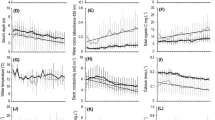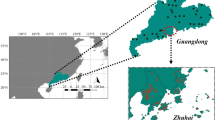Abstract
The complex nature of ecological systems limits the unambiguous determination of mechanisms that drive resilience to natural disturbance or anthropogenic stress. Using eight-year time series data from boreal lakes with and without bloom formation of an invasive alga (Gonyostomum semen, Raphidophyceae), we studied resilience of phytoplankton communities in relation to recurring bloom impacts. We first characterized phytoplankton community dynamics in both lake types using univariate metrics of community structure (evenness, species richness, biovolume and Simpson diversity). All metrics, except species richness, were substantially altered and showed an inherent stronger variability in bloom lakes relative to reference lakes. We assessed resilience mechanisms using a multivariate time series modelling technique. The models captured clear successional dynamics of the phytoplankton communities in all lakes, whereby different groups of species were substituted sequentially over the ice-free period. The models also identified that G. semen impacts in bloom lakes were only manifested within a single species group, not across species groups, highlighting the rapid renewal of the phytoplankton communities upon bloom collapse. These results provide empirical support of the cross-scale resilience model. Cross-scale resilience could provide an explanation for the paradox that similar species richnesses are seen in bloom-forming lakes and reference lakes despite the clear difference between the community features of the two different sets of lakes investigated.





Similar content being viewed by others
References
Allen CR, Gunderson L, Johnson AR (2005) The use of discontinuities and functional groups to assess relative resilience in complex systems. Ecosystems 8:958–966
Angeler DG, Moreno JM (2007) Zooplankton community resilience after press-type anthropogenic stress in temporary ponds. Ecol Appl 17:1105–1115
Angeler DG, Viedma O, Moreno JM (2009) Statistical performance and information content of time lag analysis and redundancy analysis in time series modeling. Ecology 90:3245–3257
Blomqvist P, Herlitz E (1998) Methods for quantitative assessment of phytoplankton in freshwaters, part 2 (Report 4861). Naturvårdsverket (Swedish Environmental Protection Agency), Stockholm
Brand FS, Jax K (2007) Focusing the meaning(s) of resilience: resilience as a descriptive concept and a boundary object. Ecol Soc 12(1):23. http://www.ecologyandsociety.org/vol12/is1/art23
Carpenter SR, Brock WA (2006) Rising variance: a leading indicator of ecological transition. Ecol Lett 9:311–318
Carpenter SR, Ludwig D, Brock WA (1999) Management of eutrophication for lakes subject to potentially irreversible change. Ecol Appl 9:751–771
Carpenter S, Walker B, Anderies JM, Abel N (2001) From metaphor to measurement: resilience of what to what? Ecosystems 4:765–781
Clegg MR, Maberly SC, Jones RJ (2007) Behavioural responses as a predictor of seasonal depth distribution and vertical niche separation in freshwater phytoplanktonic flagellates. Limnol Oceanogr 52:441–455
Cronberg G, Lindmark G, Björk S (1988) Mass development of the flagellate Gonyostomum semen (Raphidophyta) in Swedish forest lakes—an effect of acidification? Hydrobiologia 161:217–236
Cumming GS, Barnes G, Perz S, Schmink M, Sieving KE, Southworth J, Binford M, Holet DR, Stickler C, Van Holt T (2005) An exploratory framework for the empirical measurement of resilience. Ecosystems 8:975–987
Dray S (with contributions from P. Legendre and G. Blanchet) (2007) Packfor: forward selection with permutation (Canoco p. 46). R package version 0.0-8. http://vegan.r-forge.r-project.org/
Ellner S, Turchin P (1995) Chaos in a noisy world: new methods and evidence from time-series analysis. Am Nat 145:343–375
Eloranta P, Jarvinen M (1991) Growth of Gonyostomum semen (Ehr.) Diesing (Raphidophyceae): results from capture experiments. Verh Int Ver Theor Angew Limnol 24:2657–2659
Eloranta P, Räike A (1988) Light as a factor affecting the vertical distribution of Gonyostomum semen (Ehr.) Diesing (Raphidophyceae) in lakes. Aqua Fenn 25:15–22
Fath BD, Cabezas H, Pawlowski CW (2003) Regime changes in ecological systems: an information theory approach. J Theor Biol 222:517–530
Figueroa R, Rengefors K (2006) Life cycle and sexuality of the freshwater raphidophyte Gonyostomum semen (Raphidophyceae). J Phycol 42:859–871
Findlay DL, Paterson MJ, Hendzel LL, Kling HJ (2005) Factors influencing Gonyostomum semen blooms in a small boreal reservoir lake. Hydrobiologia 533:243–252
Forys EA, Allen CR (2002) Functional group change within and across scales following invasions and extinctions in the Everglades ecosystem. Ecosystems 5:339–347
Garmestani AS, Allen CR, Mittelstaedt JD, Stow CA, Ward WA (2006) Firm size diversity, functional richness and resilience. Environ Dev Econ 11:533–551
Garmestani AS, Allen CR, Gallagher CM, Mittelstaedt JD (2007) Departures from Gibrat’s Law, discontinuities and city size distributions. Urban Stud 44:1997–2007
Garmestani AS, Allen CR, Gunderson L (2009) Panarchy: discontinuities reveal similarity in the dynamic system structure of ecological and social systems. Ecol Soc 14:15. http://www.ecologyandsociety.org/vol14/iss1/art15
Gunderson LH (2008) Biophysical discontinuities in the Everglades ecosystem. In: Allen CR, Holling CS (eds) Discontinuities in ecosystems and other complex systems. Columbia University Press, New York, pp 83–100
Gunderson LH, Holling CS (2002) Panarchy: understanding transformations in human and natural systems. Island, Washington
Gunderson L, Allen CR, Wardwell D (2006) Temporal scaling in complex systems: resonant frequencies and biotic variability. In: Bissonette JA, Storch I (eds) Temporal dimensions of landscape ecology. Springer, Berlin, pp 78–89
Hansson LA (2000) Synergistic effects of food chain dynamics and induced behavioral responses in aquatic ecosystems. Ecology 81:842–851
Hastings A (2001) Transient dynamics and persistence of ecological systems. Ecol Lett 4:215–220
Havlicek T, Carpenter SR (2001) Pelagic species size distributions in lakes: are they discontinuous? Limnol Oceanogr 46:1021–1033
Holling CS (2001) Understanding the complexity of economic, ecological and social systems. Ecosystems 4:390–405
Hongve D, Lovstad O, Bjorndalen K (1988) Gonyostomum semen—a new nuissance to bathers in Norwegian lakes. Verh Int Ver Theor Angew Limnol 23:430–434
Janssen MA, Walker BH, Langridge J, Abel N (2000) An adaptive agent model for analysing co-evolution of management and policies in a complex rangeland system. Ecol Model 131:249–268
Kamykowski D, Yamazaki H (1997) A study of metabolism-influenced orientation in the diel vertical migration of marine dinoflagellates. Limnol Oceanogr 42:1189–1202
Le Cohu PR, Guitard J, Comoy N, Brabet J (1989) Gonyostomum semen a potential nuisance in large French reservoirs? The case of the Pareloup lake. Arch Hydrobiol 117:225–236
Legendre P, Gallagher ED (2001) Ecologically meaningful transformations for ordination of species data. Oecologia 129:271–280
Lepistö L, Antikainen S, Kivinen J (1994) The occurrence of Gonyostomum semen (Ehr.) Diesing in Finnish lakes. Hydrobiologia 273:1–8
May RM (1974) Biological populations with nonoverlapping generations: stable points, stable cycles, and chaos. Science 186:645–647
Olrik KP, Blomqvist P, Brettum P, Cronberg G, Eloranta P (1989) Methods for quantitative assessment of phytoplankton in freshwaters, Part I. Swed Environmental Protection Agency, Stockholm
Peres-Neto PR, Legendre P, Dray S, Borcard D (2006) Variation partitioning of species data matrices: estimation and comparison of fractions. Ecology 87:2614–2625
Peterson GD (2002) Contagious disturbance, ecological memory, and the emergence of landscape patterns. Ecosystems 5:329–338
Peterson GD, Allen CR, Holling CS (1998) Ecological resilience, biodiversity, and scale. Ecosystems 1:6–18
Pickhardt C, Folt CL, Chen CY, Klaue B, Blum JD (2002) Algal blooms reduce the uptake of toxic methylmercury in freshwater food webs. Proc Natl Acad Sci USA 99:4419–4423
Raffaelli D, Hall S, Emes C, Manly B (2000) Constraints on body size distributions: an experimental approach using a small-scale system. Oecologia 122:389–398
Rengefors K, Pålsson C, Hansson LA, Heiberg L (2008) Cell lysis of competitors and osmotrophy enhance growth of the bloom-forming alga Gonyostomum semen. Aquat Microb Ecol 51:87–96
Rondel C, Arfi R, Corbin D, Le Bihan F, Ndour EH, Lazzaro X (2008) A cyanobacterial bloom prevents fish trophic cascades. Freshw Biol 53:637–651
Rusak JA, Yan ND, Somers KM, McQueen DJ (1999) The temporal coherence of zooplankton population abundances in neighboring north-temperate lakes. Am Nat 153:46–58
Salonen K, Rosenberg M (2000) Advantages from diel vertical migration can explain the dominance of Gonyostomum semen (Raphidophyceae) in a small, steeply-stratified humic lake. J Plankton Res 22:1841–1853
Scheffer M, Brock W, Westley F (2000) Mechanisms preventing optimum use of ecosystem services: an interdisciplinary theoretical analysis. Ecosystems 3:451–471
Scheffer M, Rinaldi S, Huisman J, Weissing FJ (2003) Why plankton communities have no equilibrium: solutions to the paradox. Hydrobiologia 491:9–18
Smayda TJ (1997) Harmful algal blooms: their ecophysiology and general relevance to phytoplankton blooms in the sea. Limnol Oceanogr 42:1137–1153
Sommer U, Gliwicz ZM, Lampert W, Duncan A (1986) The PEG model of seasonal succession of planktonic events in fresh waters. Arch Hydrobiol 106:433–471
Stow C, Allen CR, Garmestani AS (2007) Evaluating discontinuities in complex systems: toward quantitative measures of resilience. Ecol Soc 12:26. http://www.ecologyandsociety.org/vol12/iss1/art26/
R Development Core Team (2008) R: a language and environment for statistical computing. R Foundation for Statistical Computing, Vienna. http://cran.r-project.org
Wardwell DA, Allen CR, Peterson GD, Tyre AJ (2008) A test of the cross-scale resilience model: functional richness in Mediterranean-climate ecosystems. Ecol Complex 5:165–182
Wilander A, Johnson RK, Goedkoop W (2003) Riksinventering 2000. En synoptisk studie av vattenkemi och bottenfauna i svenska sjöar och vattendrag. Institutionen för Miljöanalys, SLU, Uppsala
Acknowledgments
The data used for this study form part of a long-term monitoring program financed by the Swedish Environmental Protection Agency. Additional support of DGA and SD by the Swedish EPA is acknowledged. CT acknowledges financial support from the Ramón Areces Foundation (Spain). Thanks to Jim Grover and the reviewers for helpful comments on the manuscript.
Author information
Authors and Affiliations
Corresponding author
Additional information
Communicated by Ulrich Sommer.
Electronic supplementary material
Below is the link to the electronic supplementary material.
Rights and permissions
About this article
Cite this article
Angeler, D.G., Trigal, C., Drakare, S. et al. Identifying resilience mechanisms to recurrent ecosystem perturbations. Oecologia 164, 231–241 (2010). https://doi.org/10.1007/s00442-010-1640-2
Received:
Accepted:
Published:
Issue Date:
DOI: https://doi.org/10.1007/s00442-010-1640-2




